Phi Ta Khon, Festival of Life
It began innocently enough: an introductory speech, a line of brightly costumed children, local beauty queens smiling at spectators. But the parade lines blurred as the long procession of colorful revelers turned their attention to onlookers, teasing them with phallic swords or grabbing them for a dance. The giant masks of the Phi Ta Khon festival, artfully carved from the trunks of coconut trees, dominated the muddy street with their menacing, ghoulish grins and, if you looked a bit closer, the smiling eyes of the Thai people behind them.
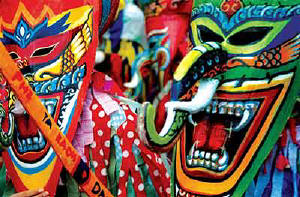 Phi Ta Khon refers to the masked “ghosts” that the villagers of Dan Sai emulate, but the procession is part of a larger traditional ceremony known as Boon Pra Wate. Its origin may involve a folktale regarding the pre-nirvana Buddha, and its modern purpose isn’t entirely clear—I heard from some that it is a rainmaking festival for the upcoming rice season; by others, a fertility festival (which would explain the abundance of phallic symbols). Nothing changes the fact that Phi Ta Khon is a joyous celebration of dancing, drinking and general mischief-making in which all are welcome to participate.
Phi Ta Khon refers to the masked “ghosts” that the villagers of Dan Sai emulate, but the procession is part of a larger traditional ceremony known as Boon Pra Wate. Its origin may involve a folktale regarding the pre-nirvana Buddha, and its modern purpose isn’t entirely clear—I heard from some that it is a rainmaking festival for the upcoming rice season; by others, a fertility festival (which would explain the abundance of phallic symbols). Nothing changes the fact that Phi Ta Khon is a joyous celebration of dancing, drinking and general mischief-making in which all are welcome to participate.
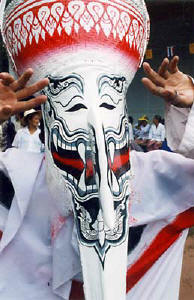
My boyfriend and I had gotten there by fate. Months earlier in Bali, a fellow traveler’s face had lit up when she heard we’d be in Thailand during the last two weeks of June. “You MUST try to go to Phi Ta Khon!” she had insisted. We were immediately intrigued to hear about the colorful craziness of this annual festival, not well known among foreigners, and I dutifully made a note of it in my journal.
Still, it wasn’t until we had arrived in Thailand that we confirmed the dates of the festival online, as they vary each year. We then solidified plans to travel northeast to Dan Sai, the small district of Loei province that hosts the festival each year. From Bangkok, we rode seven hours on a bus to Loei, about 520km away, and enlisted the help of a local driver to take us the remaining 70km to Dan Sai. Winding roads meant slow going, and over two hours passed before we reached the unassuming little village. Our driver dropped us off at the center of town, where we stood in the dark and rainy night like lost dogs with backpacks until two young Thais ran over to greet us in very limited English. Via their motorbikes and a rickety village pedicab, they helped us find our homestay, which we had reserved with the help of a booking agent in Bangkok.
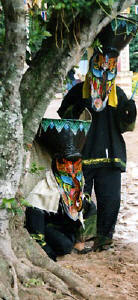
Dan Sai proper has no hotels and very few guest houses, so many families open up their homes to accommodate the annual influx of festival visitors. Family members are often shifted around in these “homestays,” and for about $3 a night, we ended up on the floor mattress of our hosts’ young daughter while she slept elsewhere.
The morning of the festival dawned gray and wet. Our hosts prepared a soupy rice breakfast and arranged for a neighbor to drive us to the village’s crowded center. A mass of Thai faces, half-hidden by umbrellas, lined the muddy road beneath large banners I could not read. Early-risers had already secured seats offered by the modest bleachers assembled on the main drag, along which stone-faced policemen stood watch. Children lingered near their mothers in vibrant costumes of multi-colored cloth, holding the huge wooden masks they would don once the opening speeches concluded. The drizzling rain did not dampen the expectant mood.

The ghosts came hesitantly at first, waiting for the handcrafted floats carrying heavily made-up girls to gain a little speed. They were mini-ghosts; children of the village passing quietly by in little bursts of color. As their sizes increased, noise and mischief levels grew proportionately. The clickety-clack of aluminum cans tied around the ankles of masked paraders mingled with the delighted shrieks of onlookers as they were poked with long, wooden swords, many of which very closely resembled male parts. The ghosts threw their hands up in mock attempts to scare their audience. The masks seemed brighter, bolder and more devilish than those worn by the children.
Interspersed with these masked villagers were other men and women dressed in camouflaged jungle outfits, exaggerated rice paddy costumes or in drag. They jumped and danced wildly about to lively music blaring from pickup trucks, some of it recorded, some of it performed live. One man threw around a gigantic fishing net, jokingly trying to catch the wooden fish in front of him, trailing on the ground behind another parader. It was about noontime, and these people had seemingly been drinking all morning—small wooden cups and vials were passed around, and the faint scent of alcohol hung in the humid air. On more than one occasion, a grinning villager approached me, poured a cup of foul alcohol and handed it over. Not wanting to risk offense, I always accepted the cup without pausing to consider its origins or past users—sometimes it is better not to—and downed it quickly to soften the burning taste.
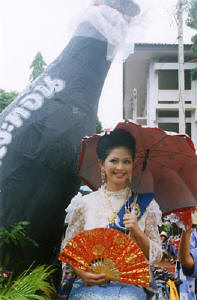
The procession culminated in a huge party in the wide courtyard of the village’s main temple, Wat Ponchai. A stage of performers provided music for the many dancers—costumed, non-costumed and half-costumed, as some of the ghosts had removed their masks to better drink or chat with friends. Spectators seeking momentary respite from the still-persistent rain took refuge under lines of covered souvenir stands. Young Buddhist monks, clad in traditional orange robes, peeked their heads out from the temple’s windows to smile at the merriment. Ironically, the two of us, snapping our cameras away at this cultural explosion, were stopped more than once to be photographed by Thai teenagers, as if being Westerners made us instant celebrities.
In a side courtyard, we discovered another party going on among the older villagers. A small crowd had gathered to watch them dance: the women gracefully swaying their hands to the music; the men jumping and swinging each other around. We eagerly joined, delighting them with our mimicry of their movements, and more alcohol was passed around. No English was spoken, and it wasn’t needed. The common denominators of our bodies and smiles were enough to communicate with our new friends.
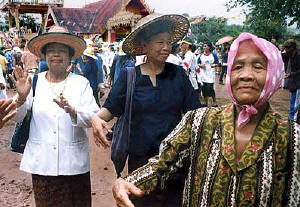
We might have danced in the rain all afternoon, but one of the women gestured for us to follow her and her entourage of lady friends to a small monastery a short walk away. There, I was made to pray on my knees before the Buddha with the other women—three short bows with three sticks of lit incense in my hands—before we all went downstairs to enjoy a feast of sticky rice, spicy cucumber salad and something resembling an omelet. The women stroked our arms, murmuring “Suay (beautiful),” and before we left them to their naps, one woman hugged us both tightly, inhaled deeply and repeated the compliment. Bellies full, we returned to the temple for more dancing, long foot massages and lots of commotion. Rockets were fired, a monk was carried around atop shoulders and men slid through the thick mud, Woodstock-style. Messy good fun.
When things quieted down and the slick brown earth reclaimed the streets and courtyards once occupied by dancing ghosts, we walked in a daze towards our homestay. The day’s sights, smells and sounds clung to us as strongly as the dampness to our clothing. In its mission to wash away the evidence, the rain continued its light drizzle on Dan Sai, but we knew our hearts and minds could never forget what we had witnessed and participated in that day: a festival of color and movement, an unquestioning acceptance of strangers, a small celebration of life.
